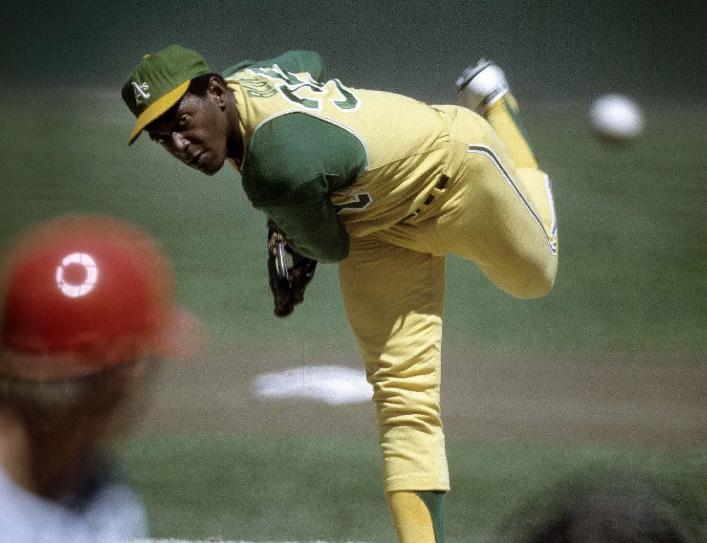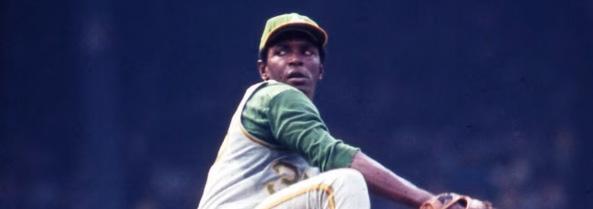
7 minute read
Vida Blue was a baseball comet

By TYLER KEPNER
Advertisement
The bright lights would come soon enough. On that May night in 1970, at the old ballpark at the confluence of the Des Moines and the Raccoon rivers, they were dimmer than the lights in the big leagues. Tony La Russa knew that much, because he’d been there.
La Russa was destined for a storied ca- reer as a major league manager, but on the field he was a bonus baby who couldn’t really hit. Playing for the Iowa Oaks, after a few trials in the majors, matched his talent level. The Iowa pitcher that night was far beyond it. He struck out 14 Evansville batters in nine innings and even had two hits at the plate.
Continues on page 28 years after he would often get asked to participate in pickup games and workouts. In 2007, he was preparing for a workout with the Fort Wayne Mad Ants, then the G League affiliate of the Indiana Pacers and the Detroit Pistons, when he spotted Rasheed Wallace, then playing for the Detroit Pistons, sitting at the bar of a T.G.I. Friday’s.
“Excuse me, sir, your turnaround jump shot is the best in the history of a turnaround jump shot,” Burney recalled telling Wallace. “How do you get it over people who are taller than you?”
Wallace got up from his seat and demonstrated his method. The two of them drank a few beers together and a friendship began.
Wallace and Ham, the Lakers’ coach, had become close over the years through NBA circles. Early this season, Wallace planned to visit Ham’s home. He asked if Burney could join.
The Lakers had started the season 2-10. Ham was struggling to make the most of the team’s two best players, LeBron James and Anthony Davis. Not many people would have used “greatness” to describe anything happening with the Lakers. But Burney did.
“He said: ‘Don’t worry, coach. You’re going to be great. We’re going to be great. I see greatness in you,’” Ham said.
Ham trusted his read on Burney, so they stayed in touch. Burney sent text messages to Ham to inspire him. The Lakers’ fortunes began to change, which likely had more to do with their dramatic makeover at the trade deadline than with Burney’s sign. But he believes something larger was happening.
Before Game 4 of the Lakers’ first-round playoff series against the Memphis Grizzlies, Burney sent a text to Ham that read: “Your PEACE gives PEACE to others!! I SEE GREATNESS IN YOU!!”
The Lakers were 6 points greater than the Grizzlies that day.
“Everyone wants to be thought of in a positive light and have — not just in basketball, NBA basketball, in life in general — you need good vibes, good energy, people that believe in you,” Ham said. “And he represents that.”
The sign outside the Lakers’ practice facility has been there for weeks. Davis saw it for the first time on May 1, just before the Lakers left Los Angeles for their series against Golden State in San Francisco.
He assumed a fan had left it there and gave it little thought.
The next day, Davis scored 30 points with 23 rebounds, joining only four other big men in Lakers history with at least 30 points and 20 rebounds in a playoff game. His performance helped the Lakers beat the Warriors in Game 1 of their series.
“Sooooo he saw the Sign before he had a RECORD setting win??” Burney said in a text message.
He could not be convinced that it was a coincidence.
From page 27
“There are minor leaguers, there are big leaguers, and then there’s that higher league of All-Stars and Hall of Famers,” La Russa, 78, said by phone Monday. “And that was Vida, and he was 20 years old.”
By the end of that 1970 season, in the majors for good with the Oakland Athletics, Vida Blue would throw a no-hitter. His next season would be a baseball comet, a wonder in both majesty and brevity, the kind of year people talk about forever, especially in moments of loss.
Blue died at age 73 Saturday, another pillar gone from the only franchise besides the New York Yankees to win three consecutive titles. Last month he visited the site of his former glory — the doomed and decaying Coliseum in Oakland, California — for a celebration of the 1973 champs, the middle of three A’s teams that won the World Series. Blue shuffled slowly to the diamond, his left hand clutching the elbow of an aide, his right holding a long, wooden cane.
“He looked really, really frail, walking around with a big pole,” Mike Norris, a former Oakland teammate, said by phone Monday. “It was sad to see. He told me he was worn out from chemo, he was weak, it was pretty painful and all that. We’re both Christians, so we just kept praying for one another. And yesterday was it.”

The news of Blue’s death reached his former catcher, Dave Duncan, late Sunday afternoon in Tucson, Arizona. Duncan, 77, was tending to his grandchildren but paused for a moment to share what he saw from behind the plate in 1971.
The left-handed Blue went 24-8 with a 1.82 ERA that season, spinning 24 complete games and eight shutouts and working 312 innings, the most in nearly 60 years by a pitcher in his first full season. He won the American League’s MVP award and the Cy Young, and there was nothing subtle about it.
“If he threw 120 pitches, 115 of them were fastballs,” said Duncan, a longtime pitching coach after his playing career. “He hardly ever threw a curveball and didn’t have a change-up. He had great control of it — he’d put it right on the hands of right-handers and right on the hands of left-handers — and he didn’t miss. He was amazing.”
The 1971 season was staggering then, incomprehensible now. Blue lost his first start and then won eight in a row, all complete games. From June 1 through July 21, he averaged more than nine innings in a stretch of 11 starts (twice he went 11 innings).
In his next start, on three days’ rest, Blue got a break: With fans jamming every corner of Tiger Stadium in Detroit, where he’d won the All-Star Game earlier that month, Blue worked only six innings. He gave up one hit and no earned runs, improving to 19-3 with a 1.37 ERA.
“He was magnetic,” said La Russa, who watched from the bench that day. “His fame spread so quickly, and he was so dynamic, that people started coming just to watch him — and he delivered. It was a circus. It was like Mark McGwire, as a hitter, in ’98 and ’99.”
Buck Martinez, a former catcher, struck out all three times he faced Blue in 1971, and 15 times overall, his most against any pitcher in a 17-year career. Martinez does remember an occasional curve amid the furi- ous fastballs — “You could hear it spin, it was so tight,” he said — and the whirl of excitement that followed Blue everywhere.
“He was much better than Mark Fidrych, but he drew the same attention as the Bird did in ’76,” Martinez said, using Fidrych’s nickname. “Everybody wanted to see Vida pitch, even if he was gonna stick it to you.”
Blue was a national sensation. On the road, his starts were the highest-attended non-opening day games for six AL teams: Baltimore, Boston, Detroit, Kansas City, the Washington Senators and the Angels. At the Coliseum, his 20 starts accounted for 40% of the season attendance.
It was a happening, and Blue, just 22 years old, had all the markings of crossover stardom: a Time magazine cover, a name-drop on “The Brady Bunch,” a spot on Bob Hope’s goodwill tour to military bases in South Vietnam; Okinawa, Japan; Thailand; and beyond. His contract talks with Charlie O. Finley, the A’s penurious owner, made for comedy fodder.
Blue: “Mr. Finley is a very persuasive man. He pointed out that I used only one arm last season.”
Hope: “So you’ll sign the same contract for next year? You’ll pitch for the same money?”
Blue: “Sure. Right-handed.”
Blue actually was a switch-hitter, and remains the answer to one of the great trivia questions: who was the last switchhitter to win American League MVP? He was not much of a hitter (.104 for his career) but carried himself with uncommon athletic grace.
“It was like watching Bo Jackson walk onto the baseball field, or Mike Trout,” said Martinez, a longtime broadcaster. “I was 10 years old when Willie Mays walked onto Seals Stadium for the first time and I was like, ‘Wow, that’s Willie Mays.’ You could tell. You didn’t have to see him do anything, and you didn’t have to see his number. But you knew that was Willie Mays. Same with Vida Blue.”
Growing up in Louisiana, Blue’s passion was football: He wore No. 32 for Jim Brown, idolized Johnny Unitas and reveled in doing it all — quarterback, cornerback, punts, kick returns. He turned down a football scholarship to the University of Houston after the death of his father, Vida Sr., a steelworker.
Blue, the oldest of six children, became the family provider. He got a $25,000 bonus from the A’s, but he struggled to extract much more from Finley. He later turned down $2,000 from Finley to change his first name to “True,” as in True Blue — the name he shared with his father mattered so much to Blue that eventually he wore VIDA on his back.
It was all part of Blue’s style, an appealing package of talent and flair that inspired future ace left-handers: a gangly kid from Livermore High in California named Randy Johnson, and a man from Vallejo, California, named Carsten Charles Sabathia Sr., whose son, C.C., became a member of the Black Aces.
Longtime pitcher Jim “Mudcat” Grant used that term as the title of his 2006 book celebrating all the Black pitchers with 20 wins in a season. There are 15 such pitchers, with Sabathia (in 2010) and another left-hander, David Price (2012), as the most recent members.
Black participation in the majors has dwindled since Blue’s era, with rising costs for amateurs, limited availability of college scholarships and the tremendous depth in international talent. Norris, 68, who joined the club in 1980, said Blue’s death was a reminder of what the sport is missing.
“The Black pitchers had more swag than everybody else,” Norris said. “I took pride in that. It’s an attitude, man, walk out there like you’re the greatest. The opposing team is like animals — they smell fear, and you combat that with your own ego.
“That’s all it is, it’s ego. And that’s one thing Vida can take to the grave: He was one of the greatest.”










